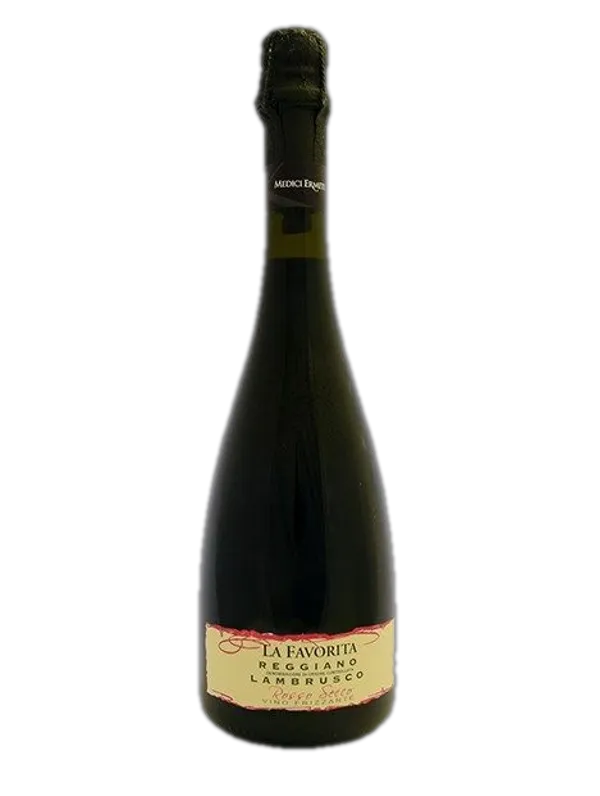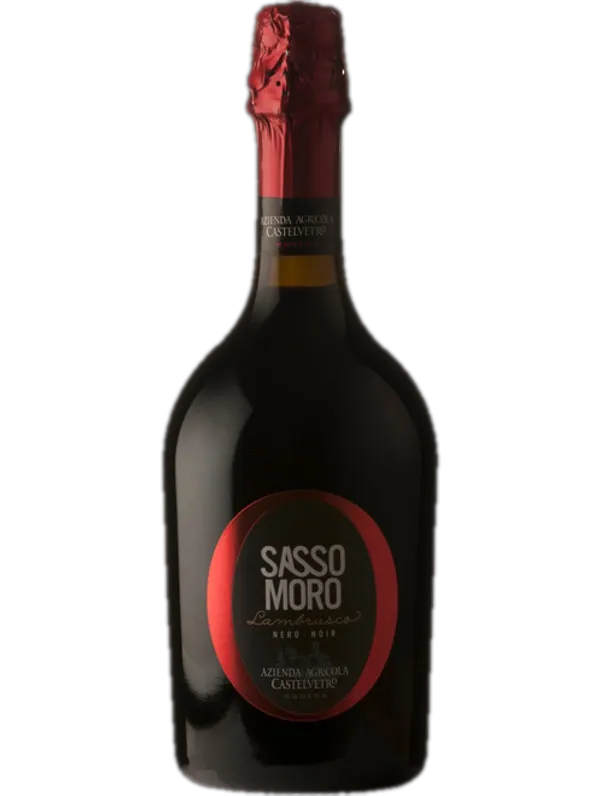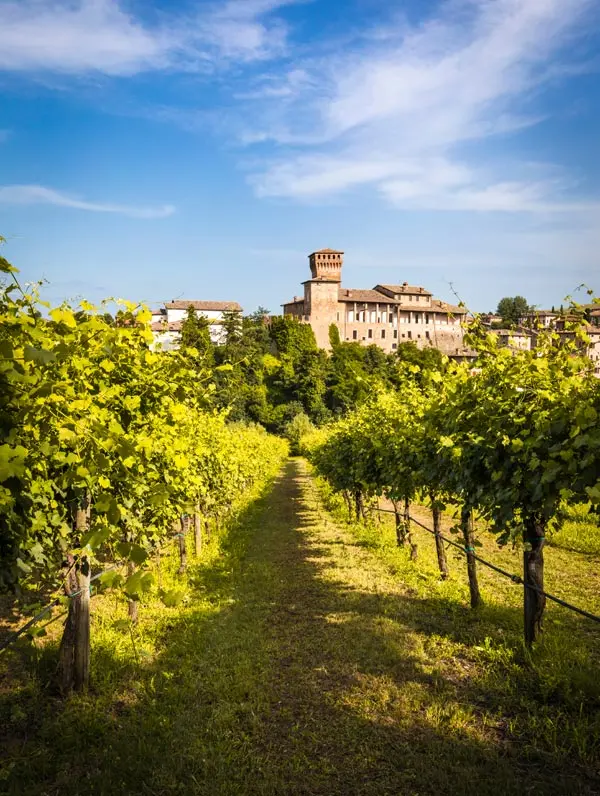Lambrusco (Lahm-BROO-sko) is a family of grapes that produces fun sparkling wines, both sweet and dry, that are among the most popular in the world. Its production is mostly concentrated in Emilia Romagna, particularly in the area between Parma, Modena and Reggio Emilia, and in Lombardia, specifically in the province of Mantua.
Primary Flavors
Raspberry
Cherry
Rose petal
Black pepper
Grape Profile
TANNIN: Mildly Present, Soft and Easy
ACIDITY: Mildly Acidic, Smooth Texture
BODY: Light to Medium, Versatile
SUGAR: Moderately Sweet, Balanced
LEVEL OF ALCOHOL: Moderately Light (7-9%)
Handling
Serve 8-13°C
Decant No
Glass Type Standard Red Wine Glass
Period open1-3 days
Cellar Between 1 and 2 Years
Our Top selection

Medici Ermete 'La Favorita' Rosso Secco, Reggiano, Lambrusco NV
A vivacious, dry Lambrusco with bold raspberry notes, perfect for a lively dinner experience.
Read more

Sassomoro Lambrusco di Modena
Vibrant purple, effervescent with a melody of Morello cherries, elderberries, and soft tannins. A playful, fruity indulgence.
Read more
Lambrusco Regions
Food Parings

Starter: Cured Meats
Emilia-Romagna is renowned for its wide variety of excellent cured meats. Mortadella, Coppa Piacentina and Prosciutto all pair well with Lambrusco Salamino.

Main course: Tortellini soup
Typical of Emilian gastronomy, tortellini are stuffed pasta. Cook them in meat broth (chicken or capon) for an authentic taste of Emilian cuisine.

Second course: Pork ribs
Lambrusco is the perfect BBQ wine especially with grilled pork; the delicate bubbles will cleanse the palate. A match made in heaven!
Lambrusco can produce a diverse style of sparkling wine, depending on the winemaker and the specific clone used. Most Lambrusco are light and undemanding wines, made to be drunk young and to be combined with traditional, simple dishes.
Dry Lambrusco, in both sparkling and frizzante versions, best accompanies dishes based on cured meats or the characteristic pasta dishes of Emilian cuisine. Sweet Lambrusco, both red and rosé, makes an excellent dessert wine; lively and fragrant.
FAQS
What kind of wine is Lambrusco?
Lambrusco is an easy to drink sparkling wine, both sweet and dry, pink or red, obtained from the fragrant Lambrusco grapes (including the various clones Grasparossa, Salamino and Sorbara).
What does Lambrusco taste like?
Lambrusco wines may different depending on the clone and the specific production area. They are normally all lively wines with plenty of red fruit, low alcohol content, delicate bubbles and gentle acidity.
Is Lambrusco dry or sweet?
Lambrusco is a sparkling red or pink wine that can produce both dry and sweet versions. Before purchasing, think carefully about the food you are about to pair it with.
Where is Lambrusco produced?
Lambrusco wines are produced in Italy and more specifically in the regions of Emilia Romagna and Lombardia. The city which produces the best quality of Lambrusco is Modena and its neighbouring beautiful hills.
What should I eat with Lambrusco?
Thanks to its freshness and lively taste, Lambrusco is the perfect aperitif. It is also an excellent companion to some of the typical dishes of Emilia Ro
Want to know it all?
Lambrusco primary flavours
Lambrusco wines can be both dry and sweet, red or pink. In all types, they are light and fresh, with a low alcohol content and intense fruity flavours of:
Raspberry
Cherry
Rose
Black Pepper
Handling of Lambrusco
Serving temperature:
8-10°C (for the sweet wines), 12-13°C (for the dry wines)Glass type:
standard red wine glassSuggested time in Decanter:
not recommendedLasting period once open:
1-3 daysStoring time in the cellar:
1-2 years
Wines made from Lambrusco
Dry Lambrusco:
Characterised by fruity scents and hints of violet. It is fresh, balanced and harmonious, with a savoury finish. It is mainly produced as a sparkling wine using the Charmat method.
Sweet Lambrusco:
The sweet versions, both red and rosé, make excellent dessert wines.
Lambrusco Grasparossa:
The Grasparossa clone gets its name from the red colour that its foliage takes on in autumn. It is a sparkling and dry wine, with aromas of cherries, plums and blackberries intertwined with hints of spice.
Lambrusco Sorbara:
An ancient indigenous variety that probably represents the best example of Lambrusco. It takes its name from the hamlet of Sorbara in the municipality of Bomporto (in the Modena province).
Lambrusco Salamino:
Originating from the province of Carpi, from which this vine has spread throughout the province of Modena, it gives a jovial and fresh wine with a ruby colour and intense fruity aromas.
History of Lambrusco
Lambrusco originates back to the ancient Romans with the name Lambrusca Vitis. Since then, it has found its place in the Italian wine industry, first, as a drink consumed by the peasants on festive occasions, and later on acquiring more popularity due to its affordable prices and appealing taste.
In the ’70s, due to a big market demand (heavily driven by the US), Lambrusco gained a bad reputation for a cheap and low-quality product. However, this has changed significantly over the past few years, thanks to a more care during the vinification process and clone choice. The wine has regained its rightful image as a refined, quality product.
Consumer Info
Price averages: £6-10
Best pairing with pasta:
tortellini in brothBest pairing with risotto & rice:
sausage and pumpkin risottoBest pairing with meat:
porkBest pairing with fish:
octopusBest pairing with cheese:
ParmesanTop 3 cuisines that pair well:
Italian, Japanese (including sushi), Chinese


